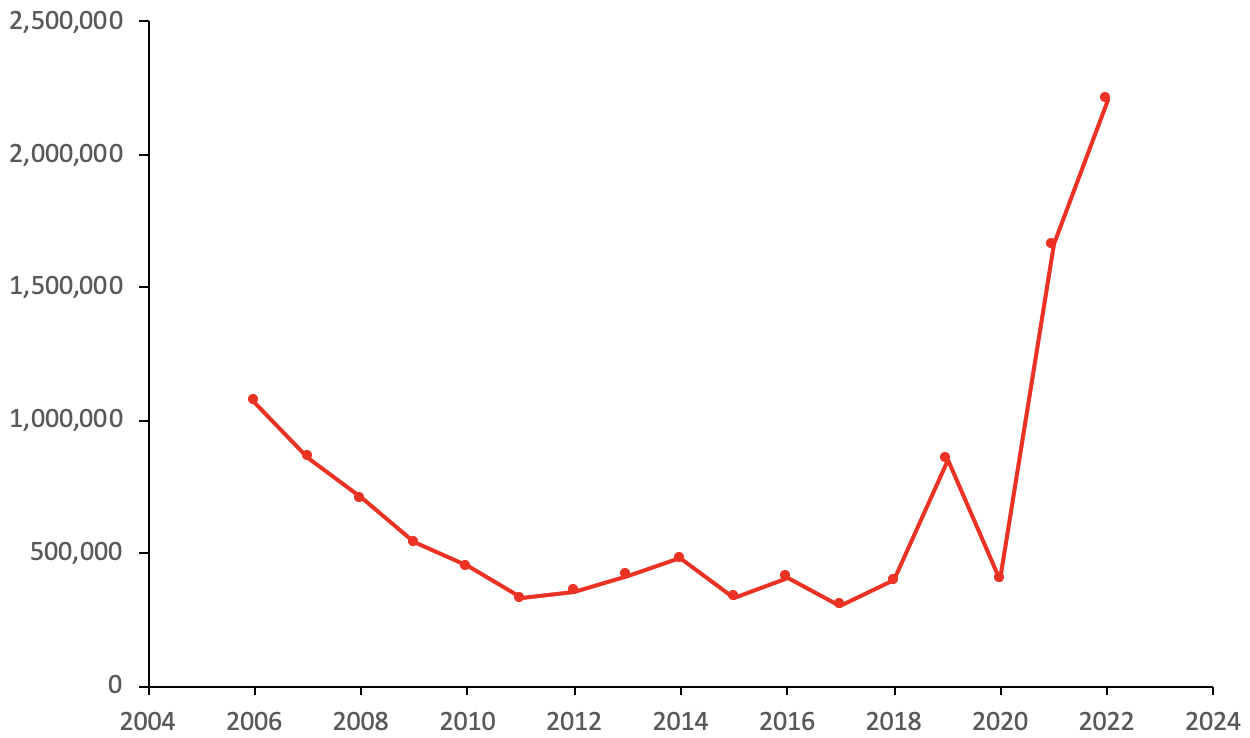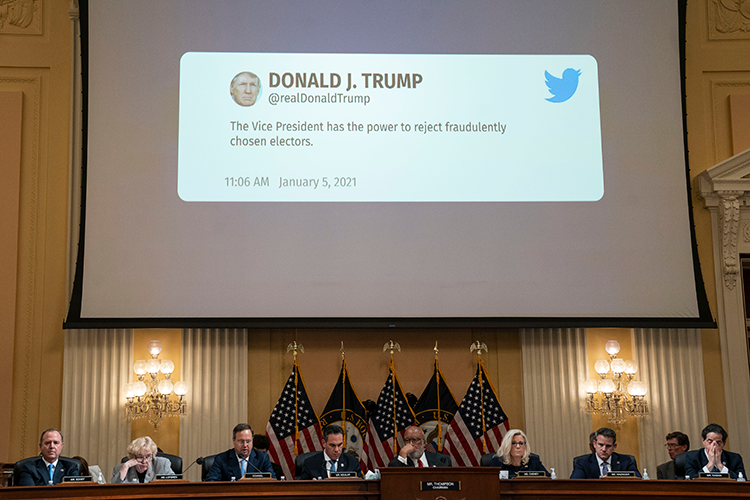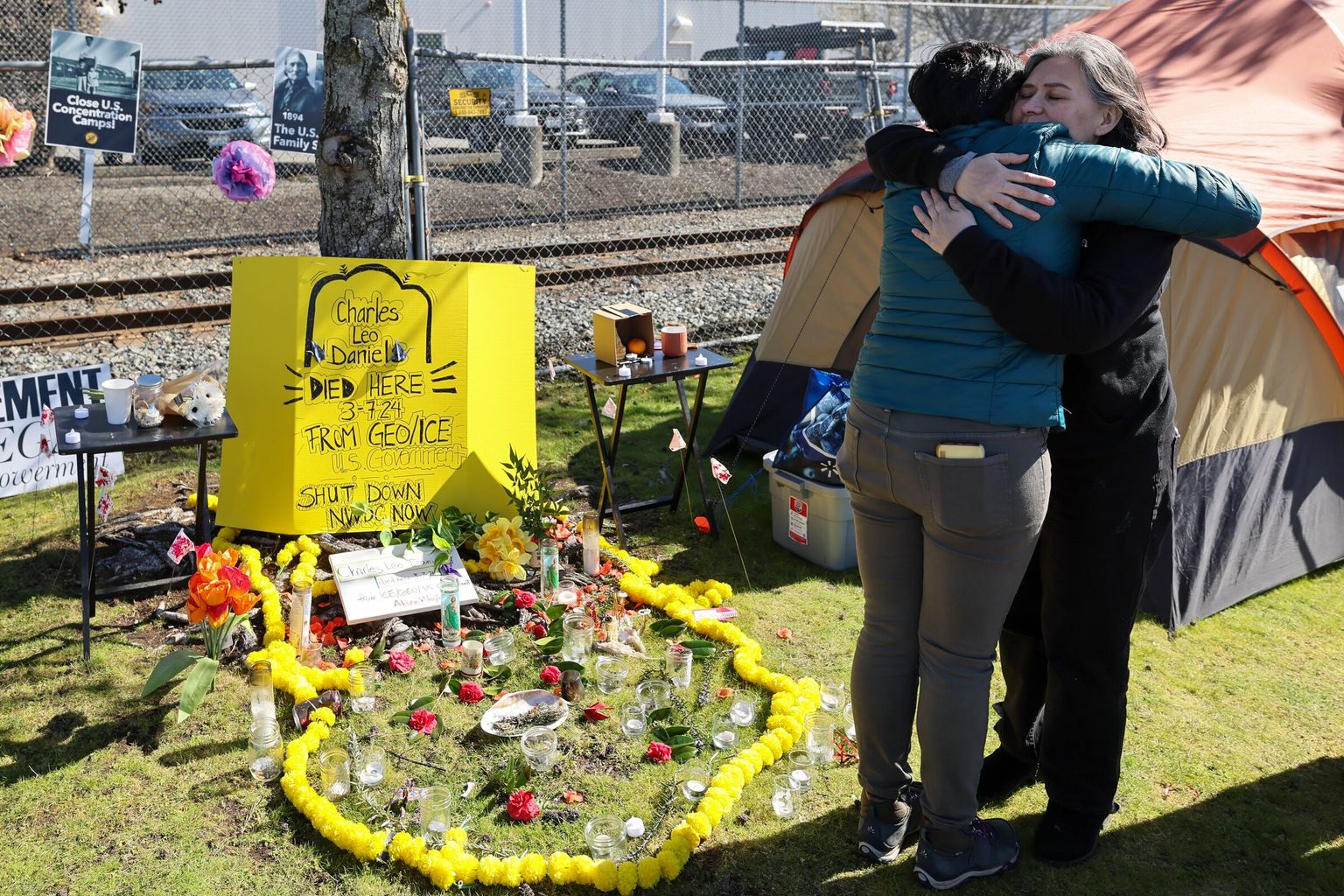Why Are Voters Concerned About Illegal Immigration and the Border?
In several recent posts, I have reported on the results of polls that suggest illegal immigration and the border are hot topics on the minds of voters — and Republicans and those who “lean Republican” in particular — in the November 8 midterm elections. To explain why immigration and the border are pressing concerns on the minds of voters, here is a depiction of what the editorial board at Bloomberg Opinion described in August as “Biden’s Border Fiasco”, in five figures.
Southwest Border Apprehensions. In March 2021, President Biden waived away concerns that illegal entries at the Southwest border were surging under his watch, contending that a then-nascent migrant wave was simply a seasonal trend that “happens every single solitary year”.
The president’s conclusions were echoed in an academic analysis that month in the Washington Post, originally headlined “There’s no migrant ‘surge’ at the U.S. southern border. Here’s the data.”
That headline was quickly changed to “The migrant ‘surge’ at the U.S. southern border is actually a predictable pattern”, but the core points were the same: There is a monthly ebb and flow in illegal entries each year, and while the then-latest was higher than usual, it was due to “people who waited during the pandemic” to come illegally.
That first point is usually true, but it quickly became clear that the number of migrants entering the United States illegally at the Southwest border under the Biden administration is significantly larger than it has ever been and has little to do with the effects of the pandemic.
How large has the migrant surge been?
Figure 1 shows the number of Border Patrol apprehensions at the Southwest border by fiscal year since FY 2006. It reveals that the migrant tsunami under Biden has been unlike anything in recorded history. The historical data from FY 2006 through FY 2019 is drawn from the Border Patrol’s records of “Total Illegal Alien Apprehensions By Month”, and the FY 2020 through FY 2022 figures from CBP’s chart of “Nationwide Encounters”:
Figure 1. Southwest Border Apprehensions, by Fiscal Year |
Not all illegal entrants are the same. Border Patrol facilities (stations and processing facilities) were built in the late 1990s and early 2000s, when nearly all migrants at the Southwest border were single adult men from Mexico. There were never meant to house children, for any duration of time.
Those facilities are suitable for that purpose because agents can process illegal single adult Mexican entrants in about eight hours, and nearly all are either quickly removed back across the border or allowed to “voluntarily return” to Mexico.
Beginning around FY 2009, however, there was a demographic shift, as the number of unaccompanied alien children (UACs) apprehended at the Southwest border began to rise.
What had started as a UAC trickle, however, quickly became a flood as migrant children — and more importantly their parents, adult family members, and smugglers — began taking advantage of a problematic law passed in late 2008, the Trafficking Victims Protection Reauthorization Act (TVPRA).
The TVPRA requires DHS to transfer UACs from “non-contiguous countries” (i.e., countries other than Mexico and Canada) to the Department of Health and Human Services within 72 hours, most for placement with “sponsors” in the United States.
While the Congressional Research Service (CRS) does not expressly blame the TVPRA for what happened next, it did explain in an August 2015 report that:
In FY2009, when the number of UAC apprehended at the Southwest border was 19,688, foreign nationals from Mexico accounted for 82% of all UAC apprehensions at the Southwest border and the three Central American countries accounted for 17% of these apprehensions. In FY2014, the proportions had almost reversed, with Mexican UAC comprising only 23% of UAC apprehensions and unaccompanied children from the three Central American countries comprising 77%.
Figure 2 shows the total number of unaccompanied alien children apprehended by agents at the Southwest border from FY 2008 to FY 2022. The historical statistics for FY 2008 to FY 2019 are drawn from the Border Patrol’s records of “Total Unaccompanied Children (0-17 Years Old) Apprehensions By Month”, and the numbers from FY 2020 to FY 2022 come from CBP’s tally of “Nationwide Encounters”:
Figure 2. Southwest Border Apprehensions, Unaccompanied Alien Children |
 |
Why do I call the TVPRA a “problematic law”? Because even President Obama realized it prevented DHS from controlling the border, and in June 2014 he sent a letter to Congress asking it to fix that “non-contiguous” country loophole. Congress failed to act, however and significantly, Biden has not sent a similar request to the Hill for action, even as UAC numbers have surged in the last two fiscal years.
Figure 3 reveals how the TVPRA has encouraged large-scale illegal immigration by UACs from non-contiguous countries. The figures for FY 2008 through FY 2019 come from that 2015 CRS report, “Unaccompanied Alien Children: An Overview”, as well as from CBP’s records of “United States Border Patrol Southwest Family Unit Subject and Unaccompanied Alien Children Apprehensions Fiscal Year 2016” (updated June 2019) and Border Patrol’s “Total Unaccompanied Children (0-17 Years Old) Apprehensions By Month”; the last three fiscal year numbers are from CBP’s “Nationwide Encounters” statistics:
Figure 3. Southwest Border UAC Apprehensions, by Fiscal Year and Nationality |
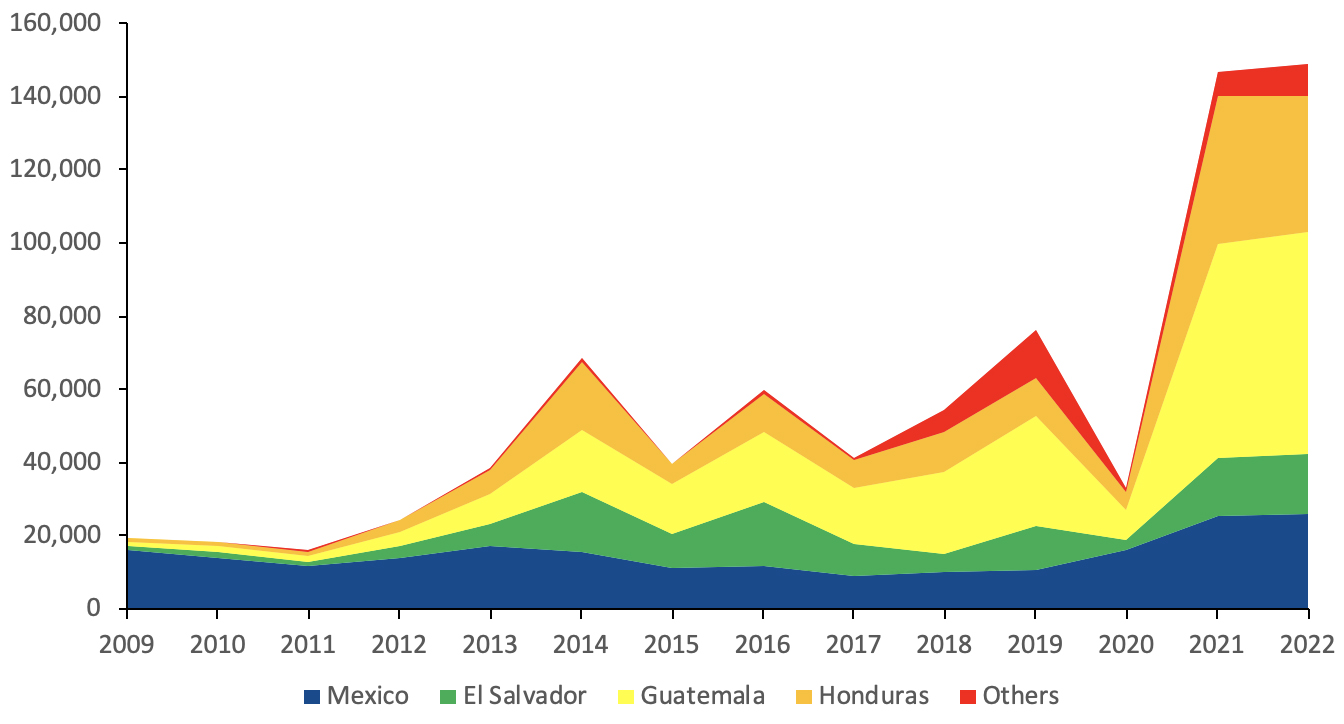 |
Again, even though most UAC apprehensions in the last two fiscal years have involved children from non-contiguous countries, the Biden administration has made no effort to amend the TVPRA or to even admit that there is a UAC problem at the border.
Southwest Border Family Unit Apprehensions. Those Border Patrol facilities at the Southwest border were also not built to accommodate adults entering illegally with children, in “family units” or “FMUs”.
The phenomenon of illegal family unit migration is also of recent vintage, beginning in approximately FY 2013. It is such a novel concept that Border Patrol didn’t even begin compiling statistics on FMU apprehensions until that fiscal year.
Faced with a large FMU influx in FY 2014, the Obama administration began housing families in military bases, to dissuade other adult migrants from attempting to enter with children. That prompted the plaintiffs in the Flores settlement agreement (FSA) — a 1997 deal agreed to by the Clinton administration — to go to court to stop the practice.
They were successful, and in August 2015, U.S. district court Judge Dolly Gee — who oversees the FSA — ordered the release of all children and adults in FMUs within 20 days (a timeframe she created of whole cloth). The Obama administration appealed that order to the Ninth Circuit, which held in July 2016 that the government could detain the adults in FMUs but had to release the children within 20 days.
To avoid “family separation”, however, most adults and children in FMUs have subsequently been released in that 20-day period.
Not surprisingly, the number of adults using children as “free tickets” to enter the United States has surged, and in FY 2019 more that half of all illegal entrants were in family units.
A bipartisan federal panel issued a report in April of that year, finding that all children in FMUs were traumatized during the journey to enter the United States illegally, and that both parents and children were exposed to unique risks on that trek. Consequently, it called on Congress to “fix” Flores, to allow DHS to deter FMUs by detaining them.
A divided Congress failed to act, prompting the Trump administration to promulgate regulations to replace Flores and allow DHS to detain illegal FMU entrants. Judge Gee quickly blocked those regulations as well, and in late December 2021 — in the waning days of the Trump administration — the Ninth Circuit affirmed that decision.
The Biden administration failed to seek Supreme Court review of the Ninth Circuit’s opinion, even though FMU apprehensions at the Southwest border swelled in FY 2021 and FY 2022. Nor has it asked Congress for a Flores fix or adopted regulations that would allow DHS to detain FMUs. To the contrary, it has stopped detaining illegal entrants who entered in FMUs, increasing the incentives.
Figure 4, drawn from Border Patrol’s “Total Family Unit Apprehensions By Month” for FY 2013 through FY 2019 and CBP’s “Nationwide Encounters” figures for FY 2020 through FY 2022, shows the results of this concatenation of bad law and policy:
Figure 4. Southwest Border Family Unit Apprehensions |
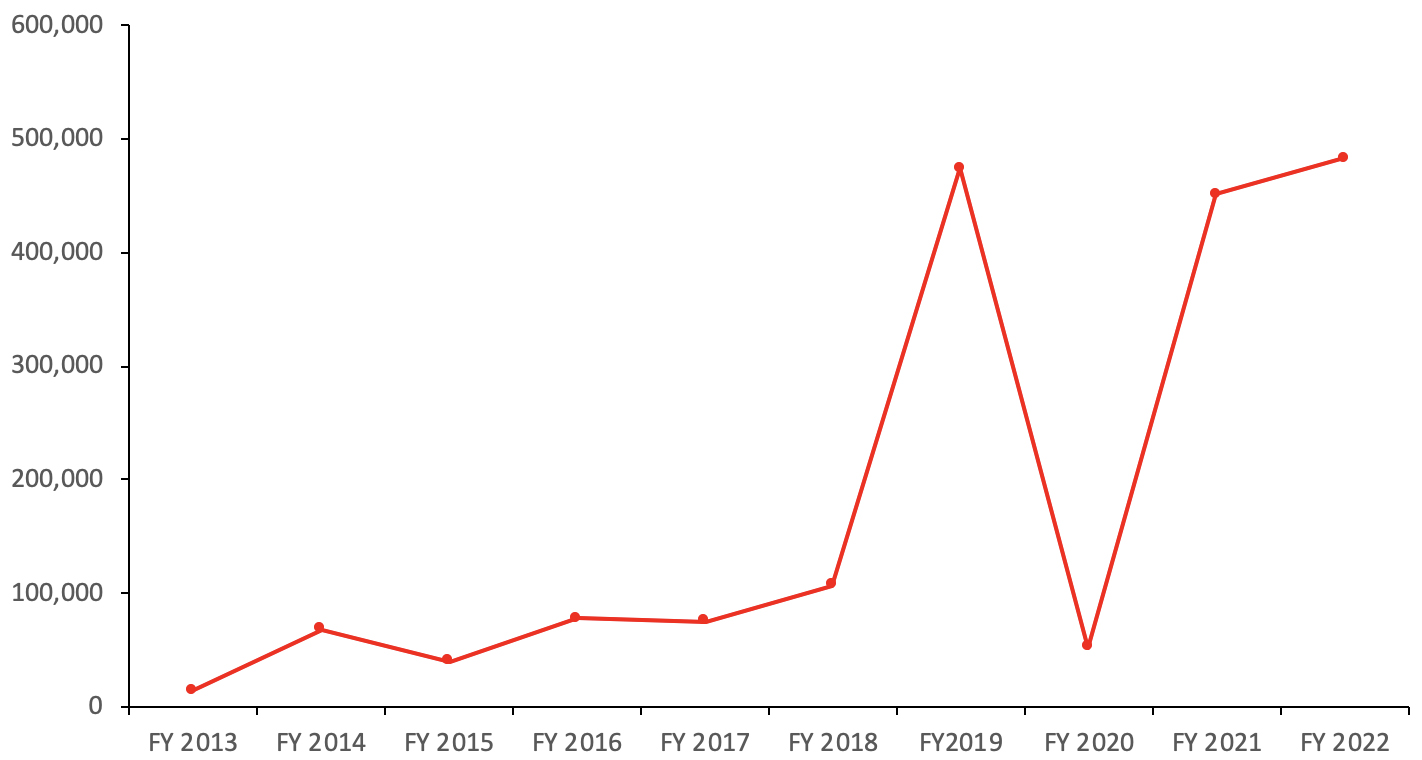 |
Illegal Migration Goes Global. As noted, until recent years, most illegal entrants were single adult males from Mexico, but beginning in FY 2014, the number of migrants who were not Mexican nationals (OTM) surged, accounting for more than half of Southwest border apprehensions.
The vast majority of those OTMs were from the three “Northern Triangle” countries of El Salvador, Guatemala, and Honduras, and the Biden administration has focused its border efforts almost exclusively on addressing the “root causes” of illegal migration (crime, corruption, poverty, and disorder) in those countries.
As my colleague, Todd Bensman (who, unlike the president and vice president has spent a lot of time on both sides of the border in the past two years) has explained, however, “‘Root causes’ aren’t behind the migrant surge — it’s open borders”.
That’s undeniably true, but even if it weren’t, the administration’s root causes focus would be in vain, as the number of illegal entrants who are both OTMs and from countries other than the Northern Triangle (ONTs) have mushroomed in the last two fiscal years.
In September, nearly 120,000 illegal entrants apprehended at the Southwest border were OTM/ONTs, just less that 58 percent of Border Patrol’s total. Unless the administration is considering a budget-busting “Marshall Plan” for the entire world, therefore, a “root causes” response to illegal migration would be useless.
Figure 5 shows how the number and percentage of OTM/ONT migrants apprehended at the Southwest border has exploded, and under Biden’s watch in particular. The figures for FY 2015 through FY 2019 are drawn from Border Patrol’s “Nationwide Apprehensions by Citizenship and Sector”, and for FY 2020 through FY 2022, from CBP’s “Nationwide Encounters” statistics:
Figure 5. Southwest Border Apprehensions, by Nationality |
 |
Biden’s Policies to Blame. Border fiascos are not inevitable like gravity or the weather. They are borne of a combination of bad laws and bad policies, and that is particularly true of the humanitarian disaster unfolding at the Southwest border.
President Biden inherited what his first Border Patrol chief, Rodney Scott, described in a September 2021 letter to Congress as “arguably the most effective border security” in U.S. history.
While Biden had campaigned on reversing many of his predecessor’s border policies, in December 2020, he promised that he would do so “at a slower pace than he initially promised, to avoid winding up with ‘2 million people on our border’”, and only after “guardrails” were in place to avoid chaos.
He was either lying or changed his mind, because it didn’t take long for Biden to begin breaking the border by rolling back the Trump policies that had allowed DHS to establish operational control there, most notably the Migrant Protection Protocols (MPP) — better known as “Remain in Mexico”.
MPP proved to be the Trump administration’s most successful deterrent to illegal entry. Under that program, OTM migrants — including in family units — were returned across the border to await their removal hearings.
In its October 2019 assessment of Remain in Mexico, DHS found MPP was “an indispensable tool in addressing the ongoing crisis at the southern border and restoring integrity to the immigration system”, particularly as related to alien families. Asylum cases were expedited under the program, and MPP removed incentives for aliens to make weak or bogus claims when apprehended.
Indispensable or not, Biden has been fighting an effort by state plaintiffs to force DHS to reimplement MPP since April 2021. That’s because, in a break from every proceeding administration, the current one has no intention of deterring foreign nationals from entering illegally.
Instead, as DHS Secretary Alejandro Mayorkas explained in May, the administration’s border objective is ensuring that there are “safe, orderly, and legal pathways for individuals to be able to access our legal system”. There is nothing “safe, orderly, or legal” about illegal entry, but to translate Biden’s plan into English, he wants to allow every foreign national who can enter illegally to apply for asylum — regardless of the strength of their claims, or even whether they come seeking asylum at all.
That has created the “open borders” that Bensman correctly blames for the fiasco. Numbers don’t lie, and the stark border numbers are available for all to see — and for those American voters who are especially concerned about illegal immigration in the upcoming midterms.
TIPP Insights just published the results of a poll it conducted of 1,359 voters, who were asked what border changes they wanted to see after the midterms. Forty-five percent of respondents want to “close the border and deport those caught”, and an additional 29 percent want to “build a wall and close the border”. Just 11 percent want to “keep the current policy in place”.
When 89 percent of the electorate is opposed to the status quo at the Southwest border, the administration has a problem. To this point, however, it has failed to admit that fact. We will see whether anything changes after the midterms.

